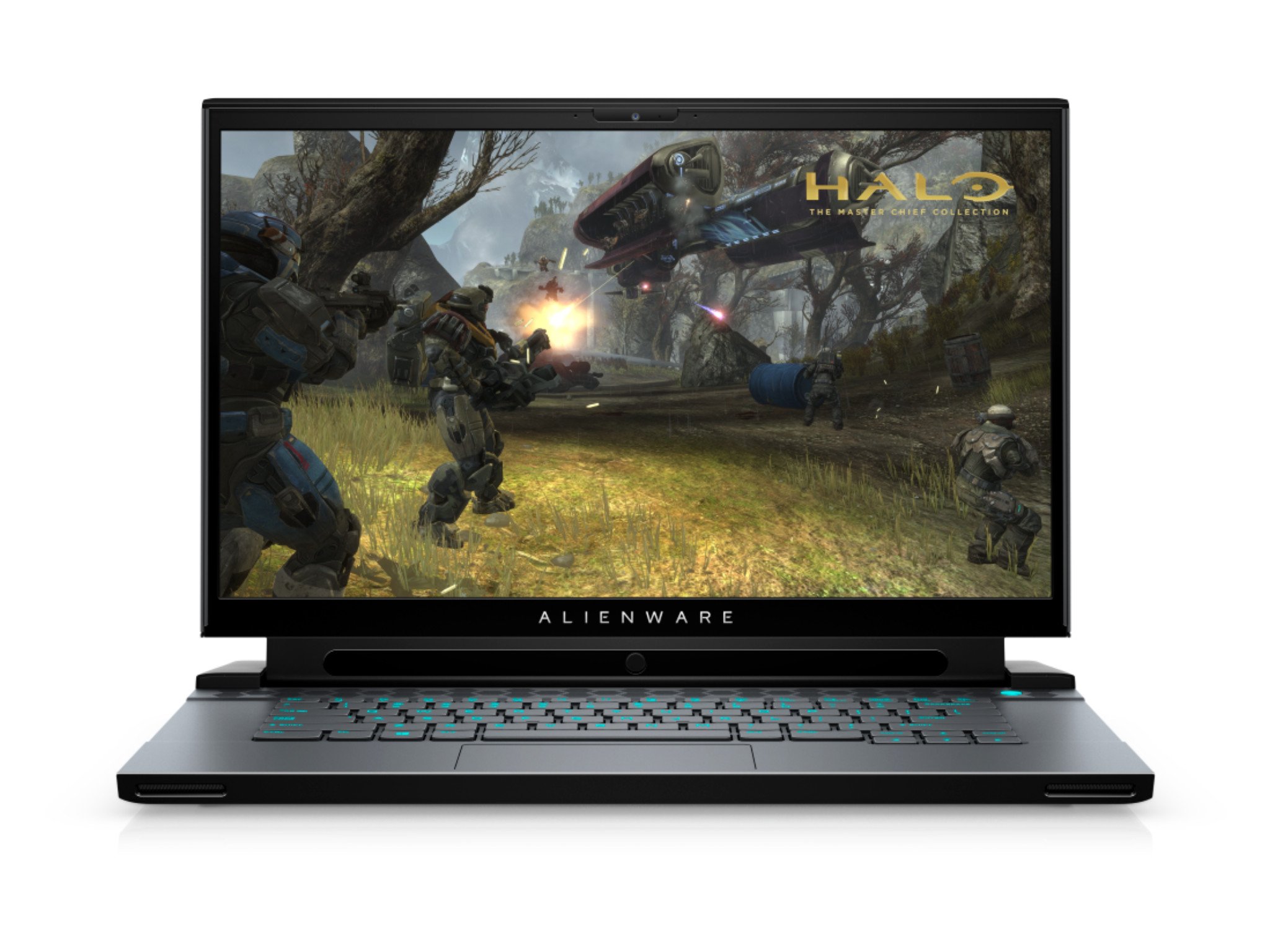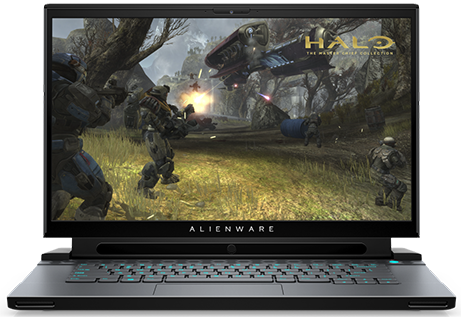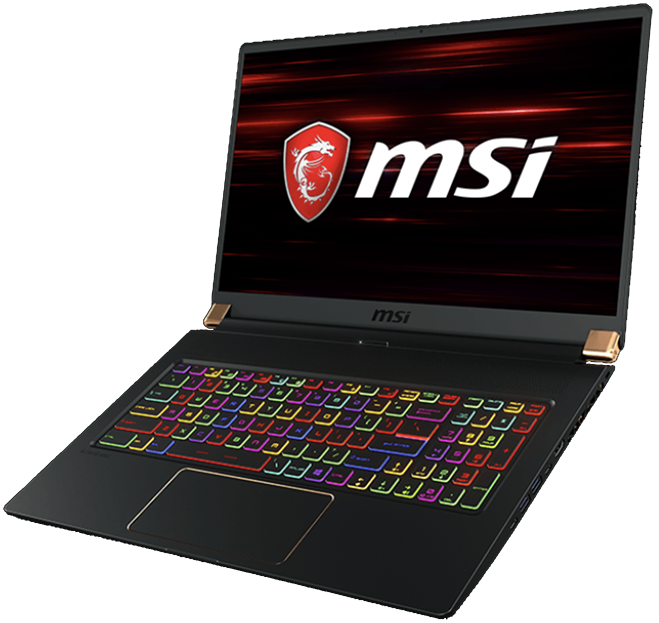The Dell Alienware m15 R3 has an impressive mix of performance configuration options, ports, display options, and pricing that makes it our top pick for a VR laptop. If its unique style isn't quite what you're looking for, there are some other suitable laptops that we've rounded up right here.
Best Overall: Dell Alienware m15 R3
Dell's Alienware m15 R3 is an excellent pick for a laptop to power VR. Models with enough power to get most headsets off the ground start at a relatively affordable price. Budget allowing, you can add up to a 10th Gen Intel Core i9-10980HK processor (CPU), NVIDIA RTX 2080 Super Max-Q graphics card (GPU) with 8GB of VRAM, 32GB of DDR4 RAM, and 4TB of M.2 PCIe solid-state drive (SSD) storage coupled with a secondary 512GB M.2 PCIe SSD.
The magnesium alloy chassis weighs just less than five pounds for a mid-range unit, and you can choose from a couple of different colors to go along with extensive RGB customization for the keyboard, lid, and vents.
Ports include three USB-A 3.1, Thunderbolt 3, HDMI 2.0, Mini DisplayPort 1.4, Ethernet, microSD (UHS-II) card reader, and 3.5mm audio. You should be able to connect any head-mounted display (HMD) with, at most, a DisplayPort adapter for newer VR systems.
Though you likely plan on having your head stuffed into a VR headset, the Alienware m15 R3 has several killer 15.6-inch display options if you'd also like to do some standard "flat" gaming. Go with 1080p and a 144Hz refresh rate as a baseline, up it to 300Hz with better color, or go all out with 4K OLED at 60Hz with a 1ms response time.
Pros:
- Impressive performance
- Reasonable starting price for VR performance
- Plenty of configurations available
- Varied port selection
- Multiple display options
Cons:
- High-end models get expensive
- Some might not like the design
Best Overall
Dell Alienware m15 R3
Something for every VR user
From a modest baseline model to a high-end powerhouse, the Alienware m15 R3 has what's needed for VR.
Runner-up: Razer Blade 15
The Razer Blade 15 Advanced model is our top pick overall for a gaming laptop, but its high-end build comes with a high-end price tag. The standard Blade 15 with up to a 10th Gen Intel Core CPU and NVIDIA RTX 2070 Max-Q GPU is thankfully significantly more affordable.
The aluminum chassis has precise angles and measures just 0.78 inches (1.99cm) thin, with an enormous Precision touchpad and keyboard with RGB lighting. Add up to an NVIDIA RTX 2070 Max-Q GPU, 10th Gen Intel Core i7-10750H CPU, 16GB of dual-channel DDR4 RAM, and a 512GB M.2 PCIe SSD for outrageous performance, then choose from 4K OLED or FHD displays. Get up to a 144Hz refresh rate in the latter, while the former tops out at 60Hz.
You'll likely need to invest in a DisplayPort adapter if you're using a newer VR system, but rest assured the Blade 15 comes with plenty of ports. HDMI 2.0, Thunderbolt 3, and three USB-A 3.2, and USB-C 3.2 should make it easy to connect everything else.
Pros:
- Thin, premium chassis
- Right ports for VR
- High-end display options available
- RGB keyboard and enormous Precision touchpad
- Huge performance
Cons:
- Runs hot due to size
- Models are expensive
Runner-up
Razer Blade 15
Expensive but exceptional
If you don't mind dropping big money alongside a VR system, the Blade 15 is going to please.
Best Value: Lenovo Legion Y545
Our top two picks for VR laptops still come in well above $1,000, and that just won't do for a lot of people. That's where Lenovo's Legion Y545 comes in. It's available in numerous configurations, but a model with NVIDIA GTX 1660 Ti GPU, 9th Gen Intel Core i5-9300H CPU, 8GB of DDR4 RAM, a 1TB hard-disk drive (HDD), and 15.6-inch FHD display costs about $1,000 after some common Lenovo instant savings are applied.
The GTX 1660 Ti GPU will deliver a solid experience for casual VR users, but if you'd like some extra juice, you can upgrade to an RTX 2060 for about $100 more. You can also boost performance by opting for a 9th Gen Intel Core i7 CPU and up to 32GB of RAM, but prices rise accordingly.
The Legion Y545 is a bit chunkier than our top two picks, but it's still undeniably a gaming laptop with aggressive lines and plenty of ports. Connect VR and other peripherals with USB-C, three USB-A 3.1, Mini DisplayPort 1.4, HDMI 2.0, Ethernet, and 3.5mm audio. Overall you're not going to get as many features here — like RGB lighting and 4K display options — but the price is sure to please those who are trying to VR off the ground on a limited budget.
Pros:
- Starts at a relatively affordable price
- Plenty of configuration options available
- Varied port selection
- 144Hz FHD display option
- Understated 15-inch design
Cons:
- Performance hardware options are limited
- Might not have enough flair for some
Best Value
Lenovo Legion Y545
Great for casual VR users
Lenovo's Legion Y545 doesn't have as much power or as many features, but the price is right.
Best 17-Inch: MSI GS75 Stealth
Part of the reason to buy a VR laptop is for portability, but you also might not want to game on a display that's any smaller than 15 inches. Enter the MSI GS75 Stealth. This 17.3-inch laptop is just 0.79 inches (20.25mm) thin and weighs in at 5.2 pounds (2.4kg), which are specs usually reserved for a smaller 15-inch laptop. The huge display comes with a 240Hz refresh rate, which makes it suitable for standard gaming when you're not wearing a VR headset.
This model comes with a 10th Gen Intel Core i7-10750H CPU, 512GB M.2 PCIe SSD, and 32GB of DDR4 RAM. Where the major performance comes is from the NVIDIA RTX 2070 Max-Q GPU with 8GB of VRAM.
The keyboard has customizable RGB lighting, and the black chassis has some gold accents for extra flair. Ports include Thunderbolt 3, USB-C 3.2, three USB-A 3.2, HDMI, Ethernet, microSD card reader, and 3.5mm audio.
Pros:
- Huge display with 240Hz refresh rate
- Right ports for VR
- Relatively thin and light for form factor
- Excellent performance hardware options
- RGB keyboard and huge touchpad
Cons:
- Quite expensive
- Larger size makes it harder to carry around
Best 17-Inch
MSI GS75 Stealth
Big but thin
If you can't live with anything less than a 17-inch display, the MSI GS75 Stealth keeps things relatively thin and light.
Thin Performance: Acer Predator Triton 500
Acer's Predator Triton 500 saw a light refresh to 10th Gen Intel hardware, though this model with a 9th Gen Intel Core i7-9750H is still going to rock your VR world (and also be quite a bit cheaper). It measures just 0.70 inches (1.78cm) thin and weighs in at 4.41 pounds (2.0kg) yet includes an NVIDIA RTX 2070 Max-Q GPU, 16GB of DDR4 RAM, and 512GB M.2 PCIe SSD. This is getting into the enthusiast level, and you should see excellent performance no matter the VR system you're using.
The keyboard has customizable RGB lighting to add some flair to the slim black body, and the bezel is thin around the display. This laptop is sleek. The 15.6-inch screen has a 144Hz refresh rate and 3ms response time for a solid flat gaming experience when you're not enjoying VR. The Predator Triton 500 has the ports needed to connect everything, including HDMI, Mini DisplayPort, four USB-A, Thunderbolt 3, Ethernet, and 3.5mm audio.
Pros:
- Sleek, light build
- Awesome performance options
- Plenty of ports
- Customizable RGB lighting
- 15.6-inch display with 144Hz refresh rate
Cons:
- High-end models are expensive
Thin Performance
Acer Predator Triton 500
Sleek laptop with high performance
Acer's Predator Triton 500 is stocked with ports and performance despite the thin and light build.
Best Customization: Origin EVO16-S
Buying a laptop generally means you can choose display and performance hardware options. For a lot of people, that's enough, but those who want to customize every aspect should check out what Origin has to offer. The EVO16-S is a 16.1-inch laptop that weighs 4.6 pounds (2.1kg) and measures 0.78 inches (1.98cm), altogether a compact package with impressive performance options.
Choose a color for the chassis and lid, then move on to hardware. Add up to a 9th Gen Intel Core i7-9750H CPU, NVIDIA RTX 2080 Max-Q GPU, 32GB of Corsair Vengeance RAM, up to 8TB of SSD storage, and numerous extra features like a fingerprint reader for extra security. The keyboard has per-key customizable RGB lighting and a smooth glass touchpad when you're not using an external mouse.
Ports include Mini DisplayPort 1.3, HDMI 2.0, two USB-C 3.1, three USB-A 3.0, 3.5mm audio, and Ethernet. If you're a VR enthusiast and want a laptop that you've picked out to fit your needs, Origin's EVO16-S should make a great choice.
Pros:
- Customize everything to your liking
- Powerful hardware options for VR
- 144Hz FHD display
- Plenty of ports
Cons:
- Quite expensive
Best Customization
Origin EVO16-S
Make it your own
Origin's EVO16-S can be extensively customized and has options to handle a high-end VR experience.
Bottom line
Thanks to a wide range of configurations starting at a relatively affordable price, Dell's Alienware m15 R3 is our top pick for a VR-capable laptop. If you're a casual user, you can go with a baseline model that will get VR off the ground, and enthusiasts can outfit something far more powerful.
No matter the hardware you choose, it comes in a stylized body with customizable RGB lighting, top-firing speakers, and a comfortable keyboard. Choose up to a 15.6-inch 4K OLED display with a 60Hz refresh rate or keep things affordable with an FHD model with a 144Hz or 300Hz refresh rate.
The Alienware m15 is stocked with ports, though newer headsets will likely require a DisplayPort adapter. Be sure to check system requirements for the VR system as well as the games you'd like to play and keep the future in mind as required specs seem only to go up.
If you'd rather stick with a desktop PC, have a look at our roundup of pre-built VR desktops, or consider building your own by first picking out a suitable GPU.
Credits — The team that worked on this guide
Cale Hunt is a staff writer at Windows Central. He focuses mainly on PC, laptop, and accessory coverage, as well as the emerging world of VR. He is an avid PC gamer and multi-platform user and spends most of his time either tinkering with or writing about tech.
Sean Endicott is an app enthusiast even though he used Windows Phone for years. He's on an eternal quest to convert every element of his home into something he can control from his phone. Oh, yeah. He's also fanatic about VR, especially the Oculus Quest.
















0 comments:
Post a Comment